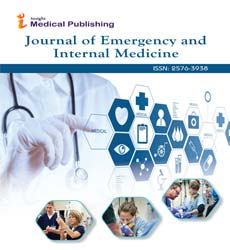ISSN : 2576-3938
Journal of Emergency and Internal Medicine
A Brief Note on Management of Pancreatic Collections
Juan Higuera Lucas*
Department of Chemistry, University of Delhi, New Delhi, India
- *Corresponding Author:
- Juan Higuera Lucas Department of Chemistry, University of Delhi, New Delhi, India, Tel: 34639618932; E-mail: jhiguera.151@gmail.com E-mail:
Received date: July 14, 2022, Manuscript No. IPJEIM-22-14092; Editor assigned date: July 18, 2022, PreQC No. IPJEIM-22-14092 (PQ); Reviewed date: August 02, 2022, QC No. IPJEIM-22-14092; Revised date: September 15, 2022, Manuscript No. IPJEIM-22-14092 (R); Published date: October 20, 2022, DOI: 10.36648/2576-3938.6.6.006
Citation: Lucas JH (2022) A Brief Note on Management of Pancreatic Collections. J Emerg Intern Med Vol:6 No:6
Description
Acute pancreatitis is an acute inflammatory process of the pancreas, which presents abdominal pain, increased amylase and lipase and shows characteristic images in imaging tests such as magnetic resonance or computed tomography. It is an important cause of hospital and intensive care unit admission, with a significant socio-health cost.
Pancreatic collections are a common complication in acute pancreatitis requiring admission to intensive care units. Manrai, et al, in their article published in the annals of surgery in 2018; reflect that up to 93.4% of necrotizing pancreatitis develops an acute collection. In total, 79.9% of all pancreatitis developed collection. The associated comorbidities, medical expense and hospital length of stay; make its management and treatment important to be reviewed.
Asymptomatic collections do not require intervention. However, symptomatic, may require it. Symptoms may include pain, fever, intolerance, nausea or vomiting. Drainage from these collections can be surgical, percutaneous, or endoscopic.
Bakker et al. tried to answer the question about which technique presents better prognosis and lower pro-inflammatory response. Compares the surgical or endoscopic procedure in relation to the control of the collection. The results reflect that the endoscopic technique reduces IL-6 levels postprocedure compared to surgical necrosectomy (P=0.004).
There are fewer numbers of multi-organic failure situations and fewer pancreatic fistulas. (10% vs. 70% P=0.02).
In relation to the comparison between percutaneous and endoscopic drainage, Akshintala et al. compared 81 patients, 41 with endoscopic treatment and 40 with percutaneous drainage, identical success rates were observed (70.7% vs. 72.5%; P=0.86).
Same adverse events, (14.6% vs. 15%; P=0.96), and clinical successes (70.7% vs. 72.5%; P=0.86). However, patients undergoing percutaneous technique had a higher rate of reoperation (42.5% vs. 9.8%; P=0.001), and longer hospital stay (14.8 ± 14.4 vs. 6.5 ± 6.7 days; P=0.001).
Endoscopic drainage of pancreatic collections is safe. The most common complications are perforation, bleeding, migration or closure of the stent. The complication rate can reach up to 21%. Vazquez et al. present the result of 211 patients, with a complication rate of 21%, in which infection is observed in 11%, bleeding in 7% and migration or perforation in 3%.
The treatment of pancreatic collections has evolved drastically in recent years. The development of drainages, endoscopic equipment and life support have improved the results of all techniques and minimized invisibility. However, these techniques, complex and more novels, need a learning process and time for their full development.
References
- Banks PA, Bollen TL, Dervenis C, Gooszen HG, Johnson CD, et al. (2013) Acute pancreatitis: an update on the revised Atlanta classification. Abdom Radiol (NY) 62:102-111
[Crossref] [Googlescholar] [Indexed]
- Manrai M, Kochhar R, Gupta V, Yadav TD, Dhaka N, et al. (2018) Outcome of Acute Pancreatic and Peripancreatic Collections Occurring in Patients With Acute Pancreatitis. Ann Surg 267:357-363
[Crossref] [Googlescholar] [Indexed]
- Bakker OJ, van Santvoort HC, van Brunschot S (2012) Endoscopic transgastric vs. surgical necrosectomy for infected necrotizing pancreatitis: a randomized trial. JAMA 307:1053-1061
[Crossref] [Googlescholar] [Indexed]
- Akshintala VS, Saxena P, Zaheer A, Rana U, Hutfless SM, et al. (2014) A comparative evaluation of outcomes of endoscopic versus percutaneous drainage for symptomatic pancreatic pseudocysts. Gastrointest Endosc 79:921-928
[Crossref] [Googlescholar] [Indexed]
- Vazquez-Sequeiros E, Baron TH, Pérez-Miranda M, Sánchez-Yagüe A, Gornals J, et al. (2016) Evaluation of the short- and long-term effectiveness and safety of fully covered self-expandable metal stents for drainage of pancreatic fluid collections: results of a Spanish nationwide registry. Gastrointest Endosc 84:450-7.e2
[Crossref] [Googlescholar] [Indexed]
- Shahid H (2019) Endoscopic management of pancreatic fluid collections. Transl Gastroenterol Hepatol 4:15
[Crossref] [Googlescholar] [Indexed]
Open Access Journals
- Aquaculture & Veterinary Science
- Chemistry & Chemical Sciences
- Clinical Sciences
- Engineering
- General Science
- Genetics & Molecular Biology
- Health Care & Nursing
- Immunology & Microbiology
- Materials Science
- Mathematics & Physics
- Medical Sciences
- Neurology & Psychiatry
- Oncology & Cancer Science
- Pharmaceutical Sciences
